- NEW DVD Series – Stone Setting with Bezels
- Tube Set Charm by Kim St. Jean
- Prong Basket Pendant by Kim St. Jean
- NEW DVD Series – Stone Setting with Cold Connections
- New DVD Series – Stone Setting with Wire
- NEW DVD Series: Introduction to Stone Setting by Kim St. Jean
- Featured Tool: Bracelet Bending Plier
- NEW Dvd by Eva Sherman
- Fun, Fast Fold Forming DVD Series
- Double Band Ear Cuff from Alex Simkin
Gem Profile October 4: Amber
Original article by Dale Cougar Armstrong, Wire-Sculpture.com

Amber
Gemstones on Wire-Sculpture.com
Our gem profile for today is perfect for this time of year, when the sun is getting more golden and beginning to set earlier each evening. Today we were going to discuss Cuprite, but our gem specialist is out sick, and so we are looking to one of our older profiles! Let’s take another look at one of our favorite stones: Amber.
What is Amber?
The gem we call Amber is fossilized tree resin, often mistakenly called fossilized tree sap. The basic difference between these two organic materials is that sap is rather thin, composed of mostly water, and runs deeper in a tree, carrying all of the nutrients the tree needs to live. In contrast, thicker resin runs just under the bark of a tree, and acts as a healing agent should the tree become damaged, blocking any holes or scrapes to prevent fungal disease and/or bugs from entering the tree. Amber is one of few, true organic materials that classify as a gemstone: the others are pearls, certain shells like abalone, jet, ivory, and coral.
The earliest amber recorded thus far, is from the Carboniferous (coal-bearing) time period, about 320 Million years ago! This rare form of amber is kept for scientific research (so don’t go looking to purchase it). Amber is one of the oldest known materials used to make jewelry. Naturally it is found in a wide variety of colors, ranging from pale yellow to deep cherry red and in rare instances, blue and green! (Note-if you are looking for what is sometimes referred to as “Black Amber,” you really want jet, which is a form of coal.)
Amber actually comes in a variety of colors! Amber is a very soft material, scoring a maximum of a 3 on Mohs scale of hardness (some samples are as soft as a 1), so be especially careful with metal pliers when wrapping amber in wire. Burmese amber is among the hardest of ambers at a 3, Baltic is in the middle, and Dominican amber can be as low as 1 on Mohs scale. That’s because Dominican amber is the youngest – at 20 – 40 million years old!
Imitation is the best form of flattery:
Amber Imitations
Copal: Being a semi-fossilized, natural hardened resin, copal is the most often used substitute as an inexpensive amber. Often sold as “young” or immature amber (being anywhere from 50 to 1.6 million years old) copal is unstable and liable to deteriorate over time, therefore it is a less suitable as a gemstone-like material. Copal is very valuable though, as it is widely used to make excellent varnish and believe it or not, in Mexico and Central America native Indians burn copal as incense during rituals. (Other popular incense “resins” include frankincense and myrrh.) The easiest way to test for copal vs. amber, is to put a drop of pure acetone in an inconspicuous place on the piece in question. Copal will become sticky very quickly whereas amber will not have any reaction. Beware of copal that is called by unusual names such as Caribbean amber, Chinese amber or Burmite, because copal can be chemically treated to change both the natural color as well as the hardness. Another type of copal that some try to pass for natural amber is called Kauri Gum, from New Zealand.
Vintage Plastics: Bakelite, Celluloid, and their varieties are valuable today because of the history attached to these materials. Mainly used in the 19th century through World War II, most of these early resins contained materials like wood, true amber shavings and rock particles along with unfavorable additions such as asbestos and formaldehyde’s. One of the names used for these amber counterfeits was “African Amber”. My new research on amber imitations also took me to a very interesting page about a vintage product called Faturan, a form of Bakelite that was used to carve prayer beads, until world-wide health implications combined with materials shortage due to World War II stopped the production of this fake amber material.
Modern Plastics: Polyester, Epoxy Resins, and Plexiglas are often made to look like amber. Sometimes copal is covered with an epoxy resin to harden the immature fossil and other times the shavings, chips and broken pieces of real amber are mixed with the resin to form the products known as “pressed” amber and reconstituted or reconstructed amber. Note: “Amberlite™” is not actually an imitation of amber but rather the trademarked name for a type of resin/ion-exchange product developed to remove impurities from water and other substances in the biopharmaceutical industry.
Glass: Although much heavier, cold and more shiny and transparent than natural amber, some vendors still try to pass off glass/silica as amber.
Traditions with Amber:
There are many myths, legends and stories associated with amber. With regards to metaphysical properties, it is most often used to stimulate intellect by opening Sahasrara, the crown chakra. The many natural colors of amber can be also used on the appropriate chakras according to their color. Basically, amber is used as a cleansing stone for both the mind and the body.
Prayer beads and rosaries are often made of amber due to the fact that rubbing amber produces warmth and static electricity, both of which are thought to be beneficial to human health, especially while meditating
Real or Fake:
Although no test is absolutely conclusive, if you have a piece of amber that you think could be very old, real and therefore very expensive, I recommend sending it to an amber expert for proper identification. If you’d like detailed information on each kind of amber authenticity test, here is a page that covers all of them: Amber Tests.
When purchasing amber, often common sense will guide you; if a truly lovely, large piece of amber is glass clear, with or without bugs, and is priced unbelievably low – it probably is a counterfeit.
Wrapping it up:
Next week we will be back on track and take a look at the gemstone Cuprite. This multi-colored mineral with dark red crystals is a beauty! You won’t want to miss it.
Do you have any jewelry you’ve created that you’d like to share with us? Send us pictures at tips@wire-sculpture.com and they could be featured!
Resources
Gem Profile originally by Dale Cougar Armstrong
Click to Receive Daily Tips by Email





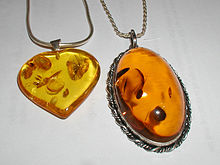
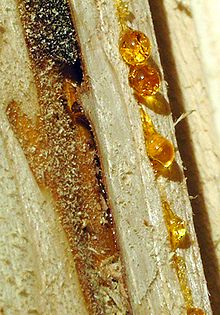
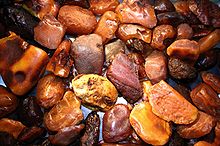
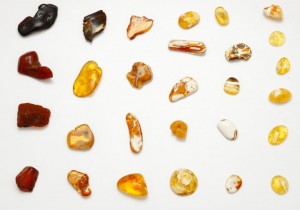

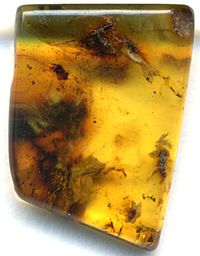














Helena
October 4, 2013 at 5:59 am
This was really interesting re history, source, and the
Ability to recognize real vs fakes.
Question: Didn’t the Russians use Amber?
Irina
October 5, 2013 at 4:09 pm
Yes, the Russians used Amber. They even had the Amber Room in one of Palaces where everything was made of Amber – walls, floor, mirror frames, and furniture. The Room was lost during World War II. The Germans dismantled and stole it. Nobody has seen it since then.
Olga
October 8, 2013 at 9:42 pm
As being Russian I’d like to help Irina answer Helena’s question.
Of course, the Russians have used Amber for making jewelry and some decorative items for centuries. Russia still remains the leading Amber supplier to the modern market.
As far as the Amber Room is concerned, I’d like to add some words about its creation and mystical history.
The Amber Room was constructed in Prussia by German designers and craftsmen in 1711 and later was presented by Prussian king Friedrich Wilhelm to the Russian Tsar Peter the Great. In Russia the Room was expanded and renovated several times in order to fit the space of the room where it was installed. It covered more than 170 square feet and weighted more than 6 tons. Due to its beauty the Amber Room was called the Eighth Wonder Of The World. It took a lot of effort to maintain The Amber Room in its beautiul condition because amber is too soft for such a huge project.The Amber Room had its own artists and lapidary workers, specially trained to reconstruct damaged amber pieces.
During the WW II The Amber Room was stolen by Nazis and never recovered. It was last seen in 1944 ans then just disappeared. Lots of historians, artists and volunteers have tried to solve the mystery of the Room. Only two pieces of furniture made of Jasper, Agate and wood have been found but none of the amber panels of the Room.
In 1979 Russia decided to reconstruct the Amber Room and in 2003, after years of hard work of the Russian craftsmen the Amber Room was open to public again. The elaborate mosaic panels made of amber also include some mirrors and gold leaf.
Those people, who saw both the original Amber Room and the new one, say that the reconstructed room looks much better than the first one. Artists who worked on the reconstruction explain this by a better quality of Amber and higher lapidary technique.
The reconstructed Amber Room is installed in the Catherine Palace near St. Petersburg. My husband and I were very lucky to see The Amber Room in December 2003, soon after its reconstruction.
Vicki E
December 31, 2015 at 11:00 am
Thank you for the explanation and history lesson. Very fascinating. Oh how awesome to have been able to actually see the reconstructed Amber Room!
Olga
October 8, 2013 at 10:08 pm
Thank you for the interesting article about amber.
I’d like to add two more facts about this gem.
Amber is light,it floats in sea cold water (cold sea water has a higher density) and its plastic imitations sink.This fact can be used as a quick identification test.
Amber pieces exposed to air and light change their color over time. My milky white amber earrings have turned dark yellow in about 20 years.
Andrea Taylor
September 15, 2015 at 5:46 am
This was very interesting,i just sold a bakelite necklace with real amber beads in between the larger ones because the triple knotted silk just fell through.A buyer asked if it was real amber? i explained quite clearly that my necklace was listed as Bakelite and explained the difference and confusion caused by the 2. Anyway another person bid and won the auction here in New Zealand and on receipt of the necklace today informed me they wanted a refund because they did a test with ultra violet light and the photos they sent with the email to say it wasnt amber but the small beads were,well hello!! i explained quite clearly that to go back and read the description and answer i gave and that legally i advertised it quite clearly as a Bakelite Butterscotch egg yolk colour.Anyway she was Chinese and said she didnt understand and was an expert on Amber,she had 7 photos i displayed and under those conditions i wont be offering a refund.I went onto Ebay and etsy and sent her pictures showing her that Bakelite can be just as expensive as Amber,some Bakelite necklaces cost from a couple of hundred US to thousands and have not heard back.Glad to see more photos today and always look forward to your tips,thanks so much Andrea
Susan
October 21, 2015 at 9:30 am
Great article regarding the Amber stones! I did some research about Amber this summer and this article sums up nearly all I read about Amber. I have a necklace my 98 year old Aunt(whom we found the past 15 years) gave me last year. The string on the necklace deteriorated so I tested the beads. They do float and when I poke one of the beads with a hot needle it did not let off any fumes but melted more like poking hard wax in that it had a string of the material following the needle as I pulled it out. Under a black light it did not glow a soft blue either. I am still on the hunch it my be bakelite since she was of that era and had a comfortable life style to buy it. She was a rock hounder like me so it could also be amber. It is not clear but a milky amber gold conformation in color. I plan on restringing it with other beads since she means a lot to me.Any ideas as to what it could be I would appreciate your insight as to what the beads maybe.